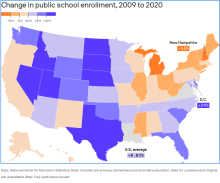
The massive expansion of Indiana's private school voucher program stands to supercharge a trend already accelerated by the pandemic — students are fleeing the state's public schools.
Why it matters: Public schools lose funding as they lose students, and some schools have been forced to shutter altogether.
- That disadvantages the many students who can't turn to private schools or homeschooling because of a lack of resources or access.
Driving the news: Indiana is moving to a near-universal voucher program, opening it up to all but the wealthiest Hoosier families.
- State lawmakers passed legislation this year to raise the income limit to 400% of the cutoff to qualify for free and reduced-price lunch, a common indicator of financial need.
- Under the new guidelines, a family of four making up to $220,000 qualifies for the tuition-assistance program.
- They also removed all other barriers to joining the program, such as having previously attended a public school.
How it works: The Choice Scholarship Program, also known as the voucher program, allows qualifying students to take up to 90% of the state dollars that would go to their local public school and put it toward their tuition at a participating private school.
- The program launched in 2011, sold by proponents to help give students from low-income families a way out of "failing" public schools because at the time it was only open to families earning 150% of the free and reduced-price lunch rate — about $60,000 for a family of four.
By the numbers: Public school enrollment has fallen roughly 2% over the past five years.
- State projections estimate that will accelerate and drop another 4% by 2025, as eligibility for the voucher school program expands.
Of note: While enrollment in traditional public schools and charters are both predicted to drop, the predicted growth in vouchers — more than 75% over the next two years — far exceeds the expected drop in public school enrollment.
- That means many students entering the voucher program next year will likely be coming from a home-school setting or their families have already been paying tuition for them to attend private school.
Zoom out: Public schools nationwide lost more than a million students from fall 2019 to fall 2020, according to the National Center for Education Statistics. Enrollment fell from 50.8 million to 49.4 million.
What's happening: Over the past decade, a number of states, including Michigan and New Hampshire, saw enrollment fall primarily due to declining birth rates, reports Erica Pandey. Others, like Texas, saw numbers rise due to immigration.
- Then the pandemic hit, and public schools were subjected to state and local guidelines. Many of them flip-flopped on virtual versus in-person learning.
- Widespread teacher and staff shortages exacerbated the problem. Students rapidly fell behind. That pushed frustrated parents to pull their kids out.
- As a result, private schools and charter schools gained students. The number of home-schooled students doubled to about 5 million.
Zoom in: While the state picks up the tab for thousands more private school students in urban and suburban areas entering the voucher program — expected to cost more than $500 million next year — some rural public schools will feel the pinch with funding increases at or below inflation.
- As those schools struggle, their students often lack other options because fewer private or charter schools exist outside major population centers.
By Arika Herron

Add new comment